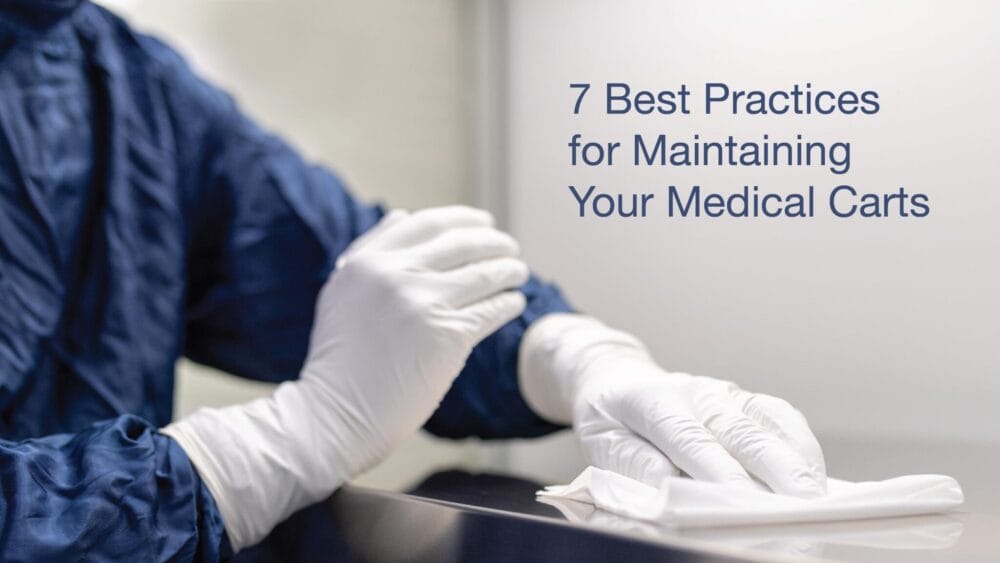
Medical carts, including crash carts and procedure carts, assist healthcare providers in providing safe and efficient patient care. It is comforting to know that supplies for a procedure or code can be wheeled up to the bedside, ready for use.
But what happens when the procedure ends? As high-touch equipment used in patient care areas, medical carts are prone to contamination with body fluids, tissue, and pathogens. Following best practice guidelines for cleaning and restocking medical carts protects both patients and staff.
Read on for 7 best practice tips for making sure your medical carts are stocked and ready to serve your patients and staff.
#1. It All Starts With a Plan
Management, nurses, and cleaning staff should be involved in developing a cleaning and restocking process.
A solid medical cart maintenance plan includes the following:
- Appropriate cleaning supplies and equipment
- Checklists and logs
- Staff training
- Ongoing monitoring of the cleaning and restocking process
- Feedback on the effectiveness of the process, with changes as needed
#2. Choose the Best Cart
Make cleaning and disinfecting easier and more effective by purchasing medical carts with the following features:
- Made of materials that resist the growth of pathogens
- Able to withstand frequent cleaning and disinfection
- Nonporous and seamless
- Designed with easy-to-clean rounded corners
Consider choosing carts that can link to a web-based tracking system. Receive alerts when carts need to be cleaned or are overdue for an inspection.
#3. Clean First
Cleaning a dirty cart always comes before disinfecting. Think of cleaning as removing all material from the surface that doesn’t belong there, such as spills, body fluids, or oils. Anything left on the surface will prevent disinfectants from doing their job.
Cleaning agents may include:
- Liquid soap
- Detergent
- Enzymatic cleaner
Require staff to wear gloves when handling cleaners and label cleaning solutions with the ingredients, concentration, and the date the solution was mixed.
Use squeeze instead of spray bottles to apply the cleaning solution to prevent spraying staff, patients, or sensitive equipment.
Cotton cloths are preferred. Consider using microfiber cloths to help grab onto grime, dust, and other particles.
#4. Disinfect Second
Once all the visible and greasy substances are removed, wet the surfaces of the cart with a disinfectant and let it air dry. This process helps to eliminate any pathogens remaining on the surface after cleaning.
Train staff to handle disinfectant solutions carefully and to use appropriate personal protective equipment (PPE). Some disinfectants require chemical-resistant gloves, a gown, and eye protection.
Commonly used disinfectants include:
- Ethyl or isopropyl alcohol
- Bleach or other chlorine-based products
- Improved hydrogen peroxide
- Quaternary ammonium compounds
As with cleaning products, use squeeze instead of spray bottles. Label containers with the ingredients, concentration, and the date it was mixed. Consider adding a disinfectant wipe holder to your carts.
#5. Restock for Efficiency
The Joint Commission recommends restocking crash carts as soon as possible after disinfecting to ensure that supplies are ready for use.
Provide visual or written restocking guidelines so the supply layout is the same after each restocking. This prevents medical staff from wasting valuable time searching for supplies.
#6. Practice Daily Maintenance
Engage your staff in conversations about the proper use of medical carts. Medical carts should not serve as shelving for miscellaneous supplies or as a catch-all cart.
Routinely inspect all medical carts for cleanliness and accuracy of contents. For example, check crash carts every eight hours or once per shift.
Develop standard operating procedures that clarify the following:
- The staff member responsible for inspecting each cart
- The staff member responsible for restocking each cart
- The frequency of inspections
- A process for cleaning and disinfecting carts
- A process for restocking
The Centers for Disease Control and Prevention recommends that you provide your cleaning and restocking staff with cleaning and restocking checklists. It may be helpful to post a laminated photo of each area or drawer that clearly shows where to place each item.
Require staff to document each cleaning and restocking on a log, including the date, time, and name of the staff member who completed the task.
#7. Automate When Possible
Save time, reduce errors, and provide traceability with a web-based tracking system.
Using an automated tracking system makes it easy to monitor the location and status of each cart linked to the system. Some monitoring systems can track medications, including when and how much was used and if the medications are nearing their expiration date.
Medical carts serve your patients by helping your medical staff provide safe, efficient care, but only if your facility has a robust action plan for keeping them clean and efficiently stocked.

Cindy Blye
Content WriterCindy Blye, BSN, RN, CCM is a Registered Nurse and Certified Case Manager. She is an Alumni of West Virginia University School of Nursing (BSN), and a member of the Association of Health Care Journalists and The Authors Guild.
